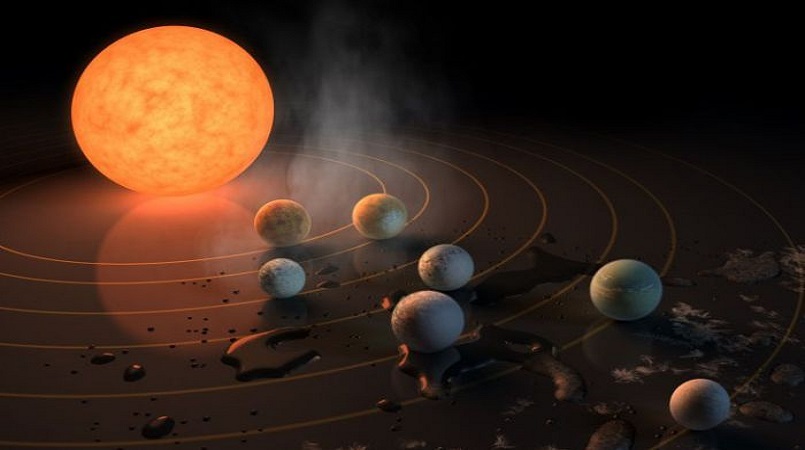
Seven Earth-sized planets, many of which could harbour life, have been discovered orbiting a dwarf star in our own galactic neighbourhood.
The complex alien solar system hosts the largest number yet of detected worlds capable of having liquid water on their surface, report a team of astronomers today in the journal Nature.
The planets have been found around TRAPPIST-1, a Jupiter-sized ultra-cool star located 40 light-years away in the constellation of Aquarius.
"It's the first time that we have so many Earth-sized planets around a star," said lead author Dr Michaël Gillon, of the Space Sciences, Technologies and Astrophysics Research Institute in Belgium.
"And furthermore it's a very nearby star and very small one, which makes it possible [to do] a lot of very detailed studies."
At least three of the planets fall within what is called the Goldilocks zone — where the temperature range on the surface may permit the existence of liquid water, considered a necessity for life.
The star made first news in May 2016 with the observation of three Earth-sized planets orbiting around it.
The planets were discovered because of the brief dimming that happened as they passed across the face of the star. But because the system is so far away, and the telescope used at the time — the Very Large Telescope in Chile — was Earth-based, researchers could only detect three planets.
"We had to go to a space telescope — the Spitzer Space Telescope — to observe the star continuously for three weeks in a row to be able to see all the transits happening," Dr Gillon said.
This revealed another four planets, also Earth-sized, all orbiting very close to the star, which is about a thousand times dimmer than our Sun and shines in a much cooler infrared part of the light spectrum.
Named from 1b to 1h in order of their distance from TRAPPIST-1, the planets take between 1.5 to 20 days to completely orbit the star — a time that is less than what it takes our Moon to orbit Earth.
Because the planets are so close to this cooler star, they receive similar amounts of energy as the inner planets in our solar system.
This means it is possible that some of the alien planets could have water on their surface.
The six inner rocky planets are located in the temperate zone, where the surface temperature could be between 0 — 100 degrees Celsius.
The three inner-most planets may be too hot to have water covering the entire surface, but the fourth, fifth and sixth planets all fall well within the Goldilocks zone, which makes them very good candidates for hosting life, said Dr Gillion.
The seventh planet, however, is likely to be too distant and cold to harbour liquid water unless there is some internal mechanism or atmosphere to keep the planet warm.
The planets are all close enough together that if a person was standing on the surface of one, they could look up and potentially see the geological features or clouds of the neighbouring world.
Scientists can't yet tell what the conditions are like on the surface of these planets, but that information could be available very soon, Dr Gillon said.
"Two years from now, the James Webb Space Telescope will be operational, so we will start getting first very detailed atmospheric properties for these planets," he said.
"So maybe we could find signs of life within a few years with these systems."
Astronomer Dr Simon O'Toole from the Anglo-Australian Observatory said the discovery was very exciting because it suggested there may be many more of these planetary systems to be found around ultra-cool dwarf stars.
"They are very hard to find because a lot of these ultra-cool dwarfs are very far away — this one just happened to be pretty close by," Dr O'Toole said.
The fact that the planets were all orbiting so close to one another meant they would be easily visible from each others' surfaces.
"In science fiction, particularly in movies but in a lot of the imagery, you get planets with views of planets very close by," Dr O'Toole said.
"When I was a student I used to think that's just silly, they're too close, you'd never get a situation like that, yet here we have it."
Dr O'Toole said the TRAPPIST-1 system was an ideal candidate to search for signals of intelligent life.
"Certainly all the SETI [Search for Extra Terrestial Intelligence] type programs will be turning directly towards it because for those programs to be successful you've got to target stars, and you can't do it unless you have some idea that there might be something there already."
